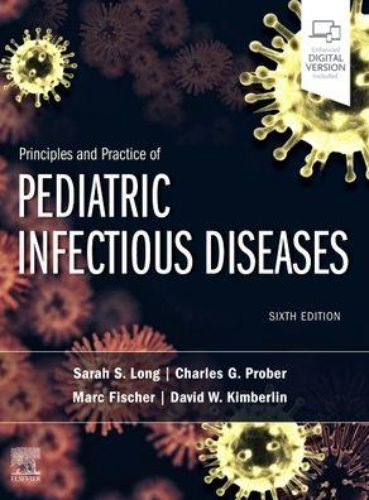상품상세정보
의학서적전문 "성보의학서적"의 신간의학도서입니다.
Comprehensive in scope, yet concise and easy to manage, Principles and Practice of Pediatric Infectious Diseases, 6th Edition, by Drs. Sarah S. Long, Charles G. Prober, Marc Fischer, and new editor David Kimberlin, is your go-to resource for authoritative information on infectious diseases in children and adolescents. A veritable "who's who" of global authorities provides the practical knowledge you need to understand, diagnose, and manage almost any pediatric infectious disease you may encounter.
Key Features
•Covers the latest aspects of the COVID-19 pandemic, including manifestations, diagnosis, management, and prevention of SARS-CoV-2 infection.
•Features an easy-access format with high-yield information boxes, highlighted key points, and an abundance of detailed illustrations and at-a-glance tables.
•Allows quick look-up by clinical presentation, pathogen, or type of host.
•Highlights expanding antimicrobial resistance patterns and new therapies for viral and fungal infections and resistant bacterial infections.
•Includes coverage of the latest vaccine products, recommendations, and effectiveness.
•Reviews emerging healthcare-associated infections, their management, control, and prevention.
•Contains a new chapter on Chorioamnionitis and Neonatal Consequences.
•Enhanced eBook version included with purchase. Your enhanced eBook allows you to access all of the text, figures, and references from the book on a variety of devices.
Author Information
Edited by Sarah S. Long, MD, Associate editor of The Journal of Pediatrics, as well as the Red Book Report of the Committee on Infectious Diseases of the American Academy of Pediatrics; Charles G. Prober, MD, Senior Associate Vice Provost for Health Education and Professor of Pediatrics (infectious diseases) and of Microbiology and Immunology at Stanford University School of Medicine; Marc Fischer, MD and David Kimberlin, MD, Professor and Co-Director, Division of Pediatric Infectious Diseases, Sergio B. Stagno, MD Endowed Chair in Pedaitric Infectious Diseases, Vice Chair for Clinical and Translational Research at Children’s Alabama, Birmingham, Alabama
- 도서목차-
1 Principles of Epidemiology and Public Health
2 Pediatric Healthcare Epidemiology: Infection Prevention and Control and Antimicrobial Stewardship
3 Infections Associated With Group Childcare
4 Infectious Diseases in Refugee and Internationally Adopted Children
5 Passive Immunization
6 Active Immunization
7 Antimicrobial Chemoprophylaxis
8 Protection of Travelers
9 Immunologic Development and Susceptibility to Infection
10 Fever and the Inflammatory Response
11 The Systemic Inflammatory Response Syndrome (SIRS), Sepsis, and Septic Shock
12 Hemophagocytic Lymphohistiocytosis and Macrophage Activation Syndrome
13 Mucocutaneous Symptom Complexes
14 Fever Without Localizing Signs
15 Prolonged, Recurrent and Periodic Fever Syndromes
16 Lymphatic System and Generalized Lymphadenopathy
17 Cervical Lymphadenitis and Neck Infections
18 Mediastinal and Hilar Lymphadenopathy
19 Abdominal and Retroperitoneal Lymphadenopathy
20 Localized Lymphadenitis, Lymphadenopathy, and Lymphangitis
21 Respiratory Tract Symptom Complexes
22 Abdominal Symptom Complexes
23 Neurologic Syndromes
24 Musculoskeletal Symptom Complexes
25 Infections of the Oral Cavity
26 The Common Cold
27 Pharyngitis
28 Infections Related to the Upper and Middle Airways
29 Otitis Media
30 Otitis Externa and Necrotizing Otitis Externa
31 Mastoiditis
32 Sinusitis
33 Bronchiolitis
34 Acute Pneumonia and Its Complications
35 Persistent and Recurrent Pneumonia
36 Pneumonia in the Immunocompromised Host
37 Endocarditis and Other Intravascular Infections
38 Myocarditis
39 Pericarditis
40 Acute Bacterial Meningitis beyond the Neonatal Period
41 Chronic Meningitis
42 Recurrent Meningitis
43 Aseptic and Viral Meningitis
44 Encephalitis
45 Parainfectious and Postinfectious Neurologic Syndromes
46 Focal Suppurative Infections of the Nervous System
47 Eosinophilic Meningitis
48 Urinary Tract Infections
49 Sexually Transmitted Infection Syndromes
50 Genitourinary Skin and Mucous Membrane Infections and Inguinal Lymphadenopathy
51 Urethritis, Vulvovaginitis, and Cervicitis
52 Pelvic Inflammatory Disease
53 Epididymitis, Orchitis, and Prostatitis
54 Infectious Diseases in Child Abuse
55 Approach to the Diagnosis and Management of Gastrointestinal Tract Infections
56 Viral Gastroenteritis
57 Inflammatory Enteritis
58 Necrotizing Enterocolitis
58 Enteric Diseases Transmitted Through Food, Water, and Zoonotic Exposures
58 Necrotizing Enterocolitis
59 Acute Hepatitis
60 Chronic Hepatitis
61 Granulomatous Hepatitis
62 Acute Pancreatitis
63 Cholecystitis and Cholangitis
64 Peritonitis
65 Appendicitis
66 Intra-Abdominal, Visceral, and Retroperitoneal Abscesses
67 Superficial Bacterial Skin Infections and Cellulitis
68 Erythematous Macules and Papules
69 Vesicles and Bullae
70 Purpura
71 Urticaria and Erythema Multiforme
72 Papules, Nodules, and Ulcers
73 Subcutaneous Tissue Infections and Abscesses
74 Myositis, Pyomyositis, and Necrotizing Fasciitis
75 Osteomyelitis
76 Infectious and Inflammatory Arthritis
77 Diskitis
78 Transient Synovitis
79 Conjunctivitis in the Neonatal Period (Ophthalmia Neonatorum)
80 Conjuctivitis beyond the Neonatal Period
81 Infective Keratitis
82 Infective Uveitis, Retinitis, and Chorioretinitis
83 Endophthalmitis
84 Preseptal and Orbital Infections
85 Infection Following Trauma
86 Infections Related to Burns
87 Infection Following Bites
88 Infections Related to Pets and Exotic Animals
89 Tickborne Infections
90 Clinical Approach to the Neonate with Suspected Infection
91 Chorioamnionitis and Neonatal Consequences
92 Bacterial Infections in the Neonate
93 Viral Infections in the Fetus and Neonate
94 Healthcare-Associated Infections in the Neonate
95 Infections in Solid Organ Transplant Recipients
96 Infections in Hematopoietic Cell Transplant Recipients
97 Risk Factors and Infectious Agents in Children with Cancer: Fever and Granulocytopenia
98 Clinical Syndromes of Infection in Children with Cancer
99 Healthcare-Associated Infections
100 Device-Associated Infections
101 Evaluation of the Child with Suspected Immunodeficiency
102 Infectious Complications of Antibody Deficiency
103 Infectious Complications of Complement Deficiency and Diseases of Its Dysregulation
104 Infectious Complications of Dysfunction or Deficiency of Polymorphonuclear and Mononuclear Phagocytes
105 Infectious Complications of Deficiencies of Cell-Mediated Immunity Other than AIDs: Primary Immunodeficiencies
106 Infectious Complications in Special Hosts
107 Infections Related to Biologic Response Modifying Drug Therapy
108 Infectious Complications of Corticosteroid Therapy
109 Epidemiology and Prevention of HIV Infection in Infants, Children, and Adolescents
110 Immunopathogenesis of HIV-1 Infection
111 Diagnosis and Clinical Manifestations of HIV Infection
112 Infectious Complications of HIV Infection
113 Management of HIV Infection
114 Classification of Bacteria
115 Staphylococcus aureus
116 Coagulase-Negative Staphylococci and Micrococcaceae
117 Classification of Streptococci
118 Streptococcus pyogenes (Group A Streptococcus)
119 Streptococcus agalactiae (Group B Streptococcus)
120 Enterococcus Species
121 Viridans Streptococci, Abiotrophia and Granulicatella Species, and Streptococcus bovis Group
122 Groups C and G Streptococci
123 Streptococcus pneumoniae
124 Other Gram-Positive, Catalase-Negative Cocci: Leuconostoc and Pediococcus Species and Other Genera
125 Neisseria meningitidis
126 Neisseria gonorrhoeae
127 Other Neisseria Species
128 Arcanobacterium haemolyticum
129 Bacillus Species (Anthrax)
130 Corynebacterium Diphtheriae
131 Other Corynebacteria
132 Listeria monocytogenes
133 Other Gram-Positive Bacilli
134 Mycobacterium tuberculosis
135 Mycobacterium Nontuberculosis Species
136 Nocardia Species
137 Escherichia coli
138 Klebsiella and Raoultella Species
139 Klebsiella granulomatis: Granuloma Inguinale (Donovanosis)
140 Enterobacter, Cronobacter, and Pantoea Species
141 Citrobacter Species
142 Less Commonly Encountered Enterobacterales
143 Plesiomonas shigelloides
144 Proteus, Providencia, and Morganella Species
145 Serratia Species
146 Salmonella Species
147 Shigella Species
148 Yersinia Species
149 Acinetobacter Species
150 Aeromonas Species
151 Less Commonly Encountered Nonenteric Gram-Negative Bacilli
152 Eikenella, Pasteurella, and Chromobacterium Species
153 Moraxella Species
154 Pseudomonas Species and Related Organisms
155 Pseudomonas aeruginosa
156 Burkholderia cepacia Complex and Other Burkholderia Species
157 Stenotrophomonas maltophilia
158 Vibrio cholerae (Cholera)
159 Other Vibrio Species
160 Bartonella Species (Cat-Scratch Disease)
161 Brucella Species (Brucellosis)
162 Bordetella pertussis (Pertussis) and Other Bordetella Species
163 Campylobacter jejuni and Campylobacter coli
164 Other Campylobacter Species
165 Capnocytophaga Species
166 Chlamydophila (Chlamydia) pneumoniae
167 Chlamydia trachomatis
168 Chlamydophila (Chlamydia) psittaci (Psittacosis)
169 Coxiella burnetii (Q fever)
170 Family Anaplasmataceae (Anaplasmosis, Ehrlichiosis, Neorickettsiosis, and Neoehrlichiosis)
171 Francisella tularensis (Tularemia)
172 Haemophilus influenzae
173 Other Haemophilus Species and Aggregatibacter Species
174 Helicobacter pylori
175 Other gastric and Enterohepatic Helicobacter species
176 Kingella Species
177 Legionella Species
178 Rickettsia rickettsii (Rocky Mountain Spotted Fever)
179 Other Rickettsia Species
180 Streptobacillus moniliformis (Rat-Bite Fever)
181 Other Gram-Negative Coccobacilli
182 Treponema pallidum (Syphilis)
183 Other Treponema Species
184 Leptospira Species (Leptospirosis)
185 Borrelia burgdorferi (Lyme Disease)
186 Other Borrelia Species and Spirillum minus
187 Anaerobic Bacteria: Clinical Concepts, and the Microbiome in Health and Disease
188 Clostridium tetani (Tetanus)
189 Clostridium botulinum (Botulism)
190 Clostridioides difficile
191 Other Clostridium Species
192 Bacteroides and Prevotella Species and Other Anaerobic Gram-Negative Bacilli
193 Fusobacterium Species
194 Anaerobic Cocci
195 Anaerobic Gram-Positive, Nonsporulating Bacilli (including Actinomycosis)
196 Mycoplasma pneumoniae
197 Other Mycoplasma Species
198 Ureaplasma urealyticum
199 Kawasaki Disease
200 Myalgic encephalomyelitis/Chronic Fatigure Syndrome
201 Classification of Human Viruses
202 Poxviridae
203 Introduction to Herpesviridae
204 Herpes Simplex Virus
205 Varicella-Zoster Virus
206 Cytomegalovirus
207 Human Herpesvirus 6 and 7 (Roseola, Exanthem Subitum)
208 Epstein-Barr Virus (Mononucleosis and Lymphoproliferative Disorders)
209 Human Herpesvirus 8 (Kaposi Sarocoma-Associated Herpesvirus)
210 Adenoviruses
211 Human Papillomaviruses
212 BK, JC, and Other Human Polyomaviruses
213 Hepatitis B and Hepatitis D Viruses
214 Human Parvoviruses (Parvovirus B19 and Bocavirus
215 Coltivirus (Colorado Tick Fever)
216 Rotaviruses
217 Togaviridae: Alphaviruses
218 Flaviviruses
219 Bunyaviruses
220 Hepatitis C Virus
221 Rubella Virus
222 Human Coronaviruses
223 Parainfluenza Viruses
224 Mumps Virus
225 Respiratory Syncytial Virus
226 Human Metapneumovirus
227 Rubeola Virus (Measles and Subacute Sclerosing Panencephalitis)
228 Rabies Virus
229 Influenza Viruses
230 Filoviruses and Arenaviruses
231 Introduction to Retroviridae
232 Human T-Cell Lymphotropic Viruses
233 Human Immunodeficiency Virus
234 Introduction to Picornaviridae
235 Polioviruses
236 Enteroviruses and Parechoviruses
237 Hepatitis A Virus
238 Rhinoviruses
239 Caliciviruses
240 Astroviruses
241 Hepatitis E Virus
242 Classification of Fungi
243 Candida Species
244 Aspergillus Species
245 Agents of Hyalohyphomycosis and Phaeohyphomycosis
246 Agents of Mucormycosis
247 Malassezia Species
248 Sporothrix schenckii Complex (Sporotrichosis)
249 Cryptococcus Species
250 Histoplasma capsulatum (Histoplasmosis)
251 Pneumocystis jirovecii
252 Blastomyces dermatitidis (Blastomycosis)
253 Coccidioides immitis and Coccidioides posadasii (Coccidioidomycosis)
254 Superficial Fungal Infections
255 Agents of Eumycotic Mycetoma: Pseudallescheria boydii and Scedosporium apiospermum
256 Classification of Parasites
257 Ectoparasites (Lice and Scabies)
258 Babesia Species (Babesiosis)
259 Balantioides coli (Formerly Balantidium coli)
260 Blastocystis Species
261 Cryptosporidium Species
262 Endolimax nana
263 Entamoeba histolytica (Amebiasis)
264 Other Entamoeba, Amebae, and Intestinal Flagellates
265 Giardia intestinalis (Giardiasis)
266 Cystoisospora (Isospora) and Cyclospora Species
267 Leishmania Species (Leishmaniasis)
268 Microsporidia
269 Naegleria fowleri
270 Acanthamoeba Species
271 Plasmodium Species (Malaria)
272 Sarcocystis Species
273 Toxoplasma gondii (Toxoplasmosis)
274 Trichomonas vaginalis
275 Trypanosoma Species (Trypanosomiasis)
276 Intestinal Nematodes
277 Tissue Nematodes
278 Blood and Tissue Nematodes (Filarial Worms)
279 Diphyllobothriidae, Dipylidium and Hymenolepis Species
280 Taenia solium, Taenia asiatica, and Taenia saginata (Taeniasis and Cysticercosis)
281 Echinococcus Species: Agents of Echinococcosis
282 Taenia (Multiceps) multiceps and Taenia serialis: Coenurosis
283 Intestinal Trematodes
284 Clonorchis, Opisthorchis, Fascioloa, and Paragonimus Species
285 Blood Trematodes: Schistosomiasis
286 Laboratory Diagnosis of Infection Due to Bacteria, Fungi, Parasites, and Rickettsiae
287 Laboratory Diagnosis of Infection Due to Viruses, Chlamydia, Chlamydophila, and Mycoplasma
288 Laboratory Manifestations of Infectious Diseases: Acute Phase Responses and Other Laboratory Manifestations of Infectious Diseases
289 Principles of Anti-Infective Therapy
290 Mechanisms and Detection of Antimicrobial Resistance
291 Pharmacokinetic and Pharmacodynamic Basis for Optimal Antimicrobial Therapy
292 Antibacterial Agents
293 Antifungal Agents
294 Topical Antimicrobial Agents
295 Antiviral Agents
296 Antiparasitic Agents / Appendix: Drugs for Parasitic Infections / Appendix: Principal Adverse Effects of Antiparasitic Drugs
296 Antiparasitic Agents / Appendix: Drugs for Parasitic Infections / Appendix: Principal Adverse Effects of Antiparasitic Drugs
기타 의학도서에 관련된 문의사항은 고객센터(02-854-2738) 또는 저희 성보의학서적 홈페이지내 도서문의 게시판에 문의바랍니다.
감사합니다.
성보의학서적 "http://www.medcore.kr




























